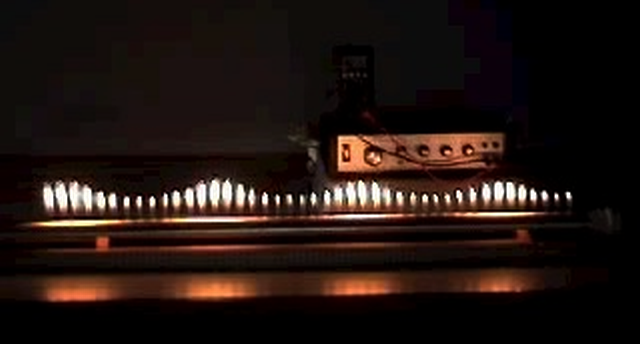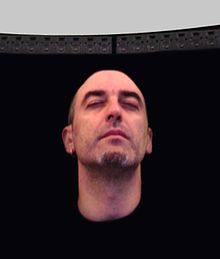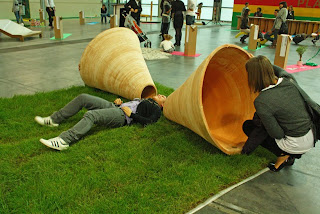Bill Fontana (born in Cleveland, Ohio) is known internationally for his pioneering experiments in sound art.
Fontana’s sound sculptures use the urban environment as a living source of musical information, all with the potential to conjure up visual imagery in the mind of the listener. (WIKI)
Thursday, 13 January 2011
Christina Kubisch -
hristina Kubisch belongs to the first generation of sound artists. Trained as a composer, she has artistically developed such techniques as magnetic induction to realize her installations. Since 1986 she has added light as an artistic element to her work with sound.
Christina Kubisch's work displays an artistic development which is often described as the "synthesis of arts" - the discovery of acoustic space and the dimension of time in the visual arts on the one hand, and a redefinition of relationships between material and form on the other. (http://www.christinakubisch.de/index_en.htm)
Christina Kubisch's work displays an artistic development which is often described as the "synthesis of arts" - the discovery of acoustic space and the dimension of time in the visual arts on the one hand, and a redefinition of relationships between material and form on the other. (http://www.christinakubisch.de/index_en.htm)
Monday, 10 January 2011
Friday, 7 January 2011
Francisco López - Contemptorary Sound Artist
Francisco López is one of the major figures of the sound art and experimental music scene. He has developed an astonishing sonic universe, absolutely personal and iconoclastic, based on a profound listening of the world. Destroying boundaries between industrial sounds and wilderness sound environments, shifting with passion from the limits of perception to the most dreadful abyss of sonic power, proposing a blind, profound and transcendental listening, freed from the imperatives of knowledge and open to sensory and spiritual expansion.
Wednesday, 5 January 2011
Sonic Art
The Fundamentals of Sonic Art and Sound Design, Tony Gibbs
The Fundamentals of Sonic Arts & Sound Design considers new approaches to sound recording, performance, installation works and exhibitions and visits the worlds of the sonic artist and the sound designer.
Hole In The Ground, Jem Finer
Artists engage with sonic art with techniques ranging from electroacoustic music, to radio, instrument hacking, kinetic sound sculptures and found footage collages.
Urban and domestic incidents "a cup of tea", Brown Sierra
exhibit using 180 speakers in Gallery/flat Wellington buildings 9th Sept-19 Sept 1999
history of sonic arts: our ancestors who gathered in the caves not just admire paintings. Apparently the paintings were found in locations where the acoustics have unusual qualities which have led some scientists to claim that the places might have been venues for early forms of multimedia events.
The first notated piece of music was found in Syria and dates back to 1400 BCE
pioneers of sound design: Edgard Varese, Steve Reich and John Cage.
Varèse's music features an emphasis on timbre and rhythm. He was the inventor of the term "organized sound", a phrase meaning that certain timbres and rhythms can be grouped together, sublimating into a whole new definition of music. Although his complete surviving works only last about three hours, he has been recognised as an influence by several major composers of the late 20th century. His use of new instruments and electronic resources led to his being known as the "Father of Electronic Music" while Henry Miller described him as "The stratospheric Colossus of Sound".
Edgard Varese - Ionisation
Steve Reich - Different Trains (Part I)
Luigi Russolo was perhaps the first noise artist
Italian futurist Luigi Russolo and in particular his 1913 treatise The Art of Noises that puts forward an idea revolutionary for the time: there should be no barriers between sounds that have musical or instrumental origins and those who come from the street, the industry or even warfare. He tried to prove his point with his Intonarumori (or Noise Intoners) machines. Each of them produced a particular type of noise, there was the Ululator (the howler), the Crepitatori (the crackers), and the Stropicciatore (the rubber). On April 24, 1914, he conducted the first 'Gran Concerto Futuristica' with musicians playing those noise machines. The audience responded by throwing vegetables, booing, hooting and whistling.
The Fundamentals of Sonic Arts & Sound Design considers new approaches to sound recording, performance, installation works and exhibitions and visits the worlds of the sonic artist and the sound designer.
Hole In The Ground, Jem Finer
Artists engage with sonic art with techniques ranging from electroacoustic music, to radio, instrument hacking, kinetic sound sculptures and found footage collages.
Urban and domestic incidents "a cup of tea", Brown Sierra
exhibit using 180 speakers in Gallery/flat Wellington buildings 9th Sept-19 Sept 1999
history of sonic arts: our ancestors who gathered in the caves not just admire paintings. Apparently the paintings were found in locations where the acoustics have unusual qualities which have led some scientists to claim that the places might have been venues for early forms of multimedia events.
The first notated piece of music was found in Syria and dates back to 1400 BCE
pioneers of sound design: Edgard Varese, Steve Reich and John Cage.
Varèse's music features an emphasis on timbre and rhythm. He was the inventor of the term "organized sound", a phrase meaning that certain timbres and rhythms can be grouped together, sublimating into a whole new definition of music. Although his complete surviving works only last about three hours, he has been recognised as an influence by several major composers of the late 20th century. His use of new instruments and electronic resources led to his being known as the "Father of Electronic Music" while Henry Miller described him as "The stratospheric Colossus of Sound".
Edgard Varese - Ionisation
Steve Reich - Different Trains (Part I)
Luigi Russolo was perhaps the first noise artist
Italian futurist Luigi Russolo and in particular his 1913 treatise The Art of Noises that puts forward an idea revolutionary for the time: there should be no barriers between sounds that have musical or instrumental origins and those who come from the street, the industry or even warfare. He tried to prove his point with his Intonarumori (or Noise Intoners) machines. Each of them produced a particular type of noise, there was the Ululator (the howler), the Crepitatori (the crackers), and the Stropicciatore (the rubber). On April 24, 1914, he conducted the first 'Gran Concerto Futuristica' with musicians playing those noise machines. The audience responded by throwing vegetables, booing, hooting and whistling.
Sunday, 2 January 2011
Peter Cusack - Interactive Web map
Peter Cusack is an artist and musician who is a member of CRiSAP (Creative Research in Sound Art & Performance), and is a research staff member and founding member of the London College of Communication in the University of the Arts London. He was a founding member and director of the London Musicians’ Collective. (Wiki)
His website is an interesting interactive map that maps different sounds from a city
http://www.petercusack.org/ - Currently London only
His website is an interesting interactive map that maps different sounds from a city
http://www.petercusack.org/ - Currently London only
Saturday, 1 January 2011
chiara pacifici: odi
the simple conical forms, crafted entirely out of terracotta, act as a set of enlarged ears.
users lay on their backs with their heads in between the set of cones to listen for illuminations
of the noises surrounding them. using resonance, the device outputs sinusoidal waves of
diffused, oscillating sound into the listener's ears.
the simple conical forms, crafted entirely out of terracotta, act as a set of enlarged ears.
users lay on their backs with their heads in between the set of cones to listen for illuminations
of the noises surrounding them. using resonance, the device outputs sinusoidal waves of
diffused, oscillating sound into the listener's ears.
John Cage
"M is, to be sure, the first letter of many words and names that have concerned me for many years( music, mushrooms, marcel duchamp, M.C.Richards, Morris Graves, Mark Tobey, Merce Cunningham, ...)"
"I love sounds, just as they are, I have no need for them to be anything more, than what they are, I dont want them to be psychological, I dont want the
George Brecht - Drip Music
Mimique. A Pierrot story. The Pierrot character associates silence with whiteness. The two most remarkable and typical features of the Pierrot are that it tells its story in silence and that his face is white (neutrality or utter coldness?). Throughout the history of the Pierrot story, silence and whiteness are inextricably linked.
http://www.cobussen.com/proefschrift/300_
Subscribe to:
Comments (Atom)












